CADILLAC ELDORADO 1997 10.G Owners Manual
Manufacturer: CADILLAC, Model Year: 1997, Model line: ELDORADO, Model: CADILLAC ELDORADO 1997 10.GPages: 361, PDF Size: 22.85 MB
Page 91 of 361
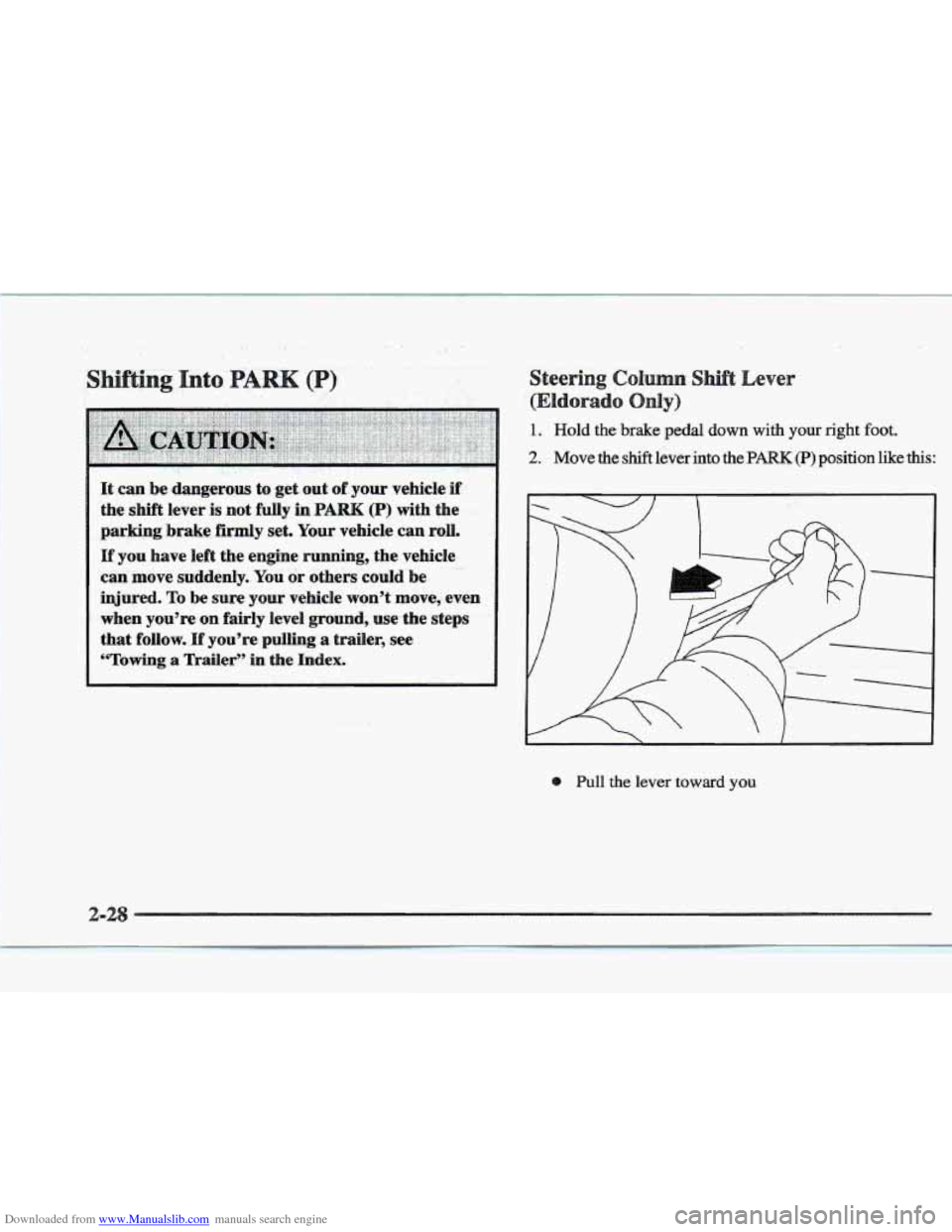
Downloaded from www.Manualslib.com manuals search engine . , .. (P):
It can be dangerous to get. out of your vehicle if
the shift lever is not fully in PARK (P) with the
parking brake
firmly set. Your vehicle can roll.
If you have left the engine running, the vehicle
can move suddenly..You
or others could be
injured.
To be sure your vehicle won’t move, even
when you’re on fairly level ground, use. the steps
that follow.
If you’re pulling a trailer, see
“Towing a Trailer’, in the Index.
1. Hold the brake pedal down with your right foot.
2. Move the shift lever into the PARK (P) position like this:
J
e Pull the lever toward you
Page 92 of 361
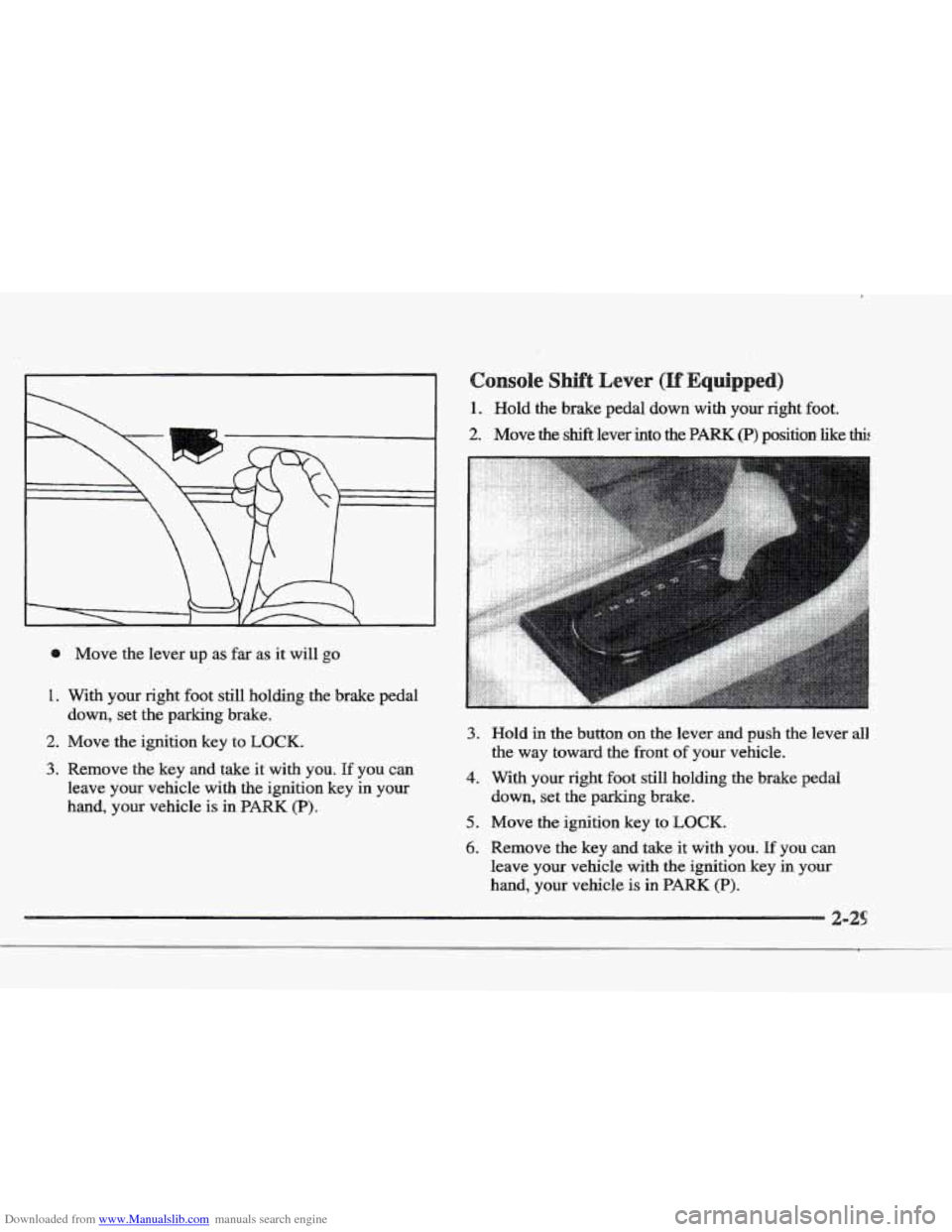
Downloaded from www.Manualslib.com manuals search engine 6 Move the lever up as far as it will go
1. With your right foot still holding the brake pedal
down, set the parking brake.
2. Move the ignition key to LOCK.
3. Remove the key and take it with you. If you can
leave your vehicle with the ignition key in your
hand, your vehicle
is in PARK (P).
1. Hold the brake pedal down with your right foot.
2. Move the shift lever into the PARK (P) position like thi:
3.
4.
5.
6.
Hold in the button on the lever and push the lever all
the way toward the front of your vehicle.
With your right foot still holding the brake pedal
down, set the parking brake.
Move the ignition key to
LOCK.
Remove the key and take it with you. If you can
leave your vehicle with the ignition key in your
hand, your vehicle
is in PARK (P).
Page 93 of 361
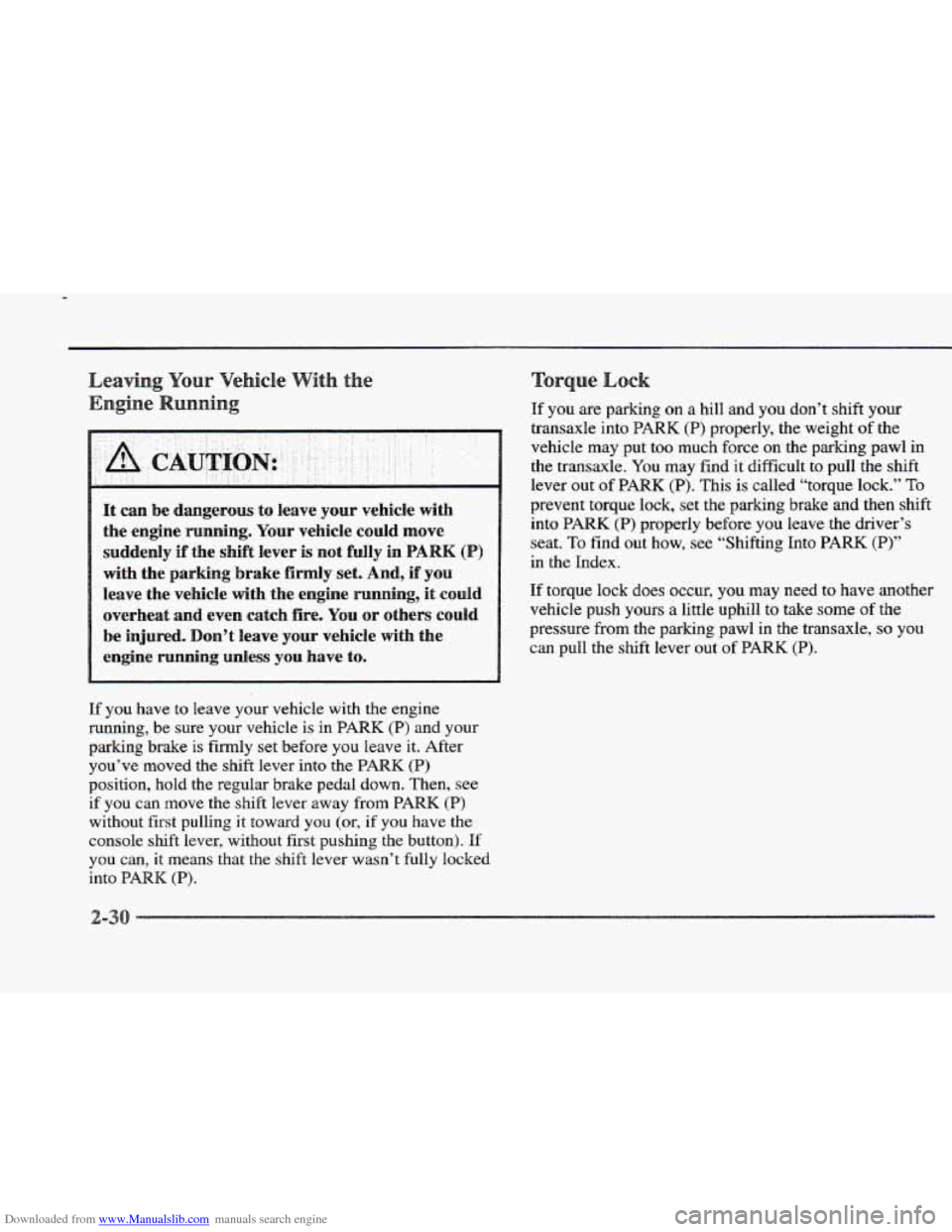
Downloaded from www.Manualslib.com manuals search engine It can be dangerous to leave your vehicle with
the engine running.
Your vehicle could move
suddedy i€ the shift lever is not fully in PARK (
with the parking brake firmly set. And, if you
leave the vehicle with the engine running, it cdd
overheat and even catch fire. You or others could
be injured. Don’t leave your vehicle with the
engine running unless you have to.
If you have to leave your vehicle with the engine
running, be sure your vehicle
is in PARK (P) and your
parking brake
is firmly set before you leave it. After
you’ve moved the shift lever into the
PARK (P)
position, hold the regular brake pedal down. Then, see
if you can move the shift lever away from PARK (P)
without first pulling it toward you (or, if you have the
console shift lever, without first pushing the button).
If
you can, it means that the shift lever wasn’t fully locked
into
PARK (I?).
If you are parking on a hill and you don’t shift you
transaxle into PARK (PI properly, the weight of the
vehicle may put too much force on the parking pawl in
the transaxle. You
may find it difficult to pull the shift
lever out of
PARK (P). This is called “torque lock.” To
prevent torque lock, set the parking brake and then shift
into
PARK (I?) properly before you leave the driver’s
seat.
To find out how, see “Shifting Into PARK (P)”
in the Index.
If torque lock does occur, you may need to have another
vehicle
push yours a little uphill to take some of the
pressure from the parking pawl
in the transaxle, so you
can pull the
shift lever out of PARK (P).
Page 94 of 361
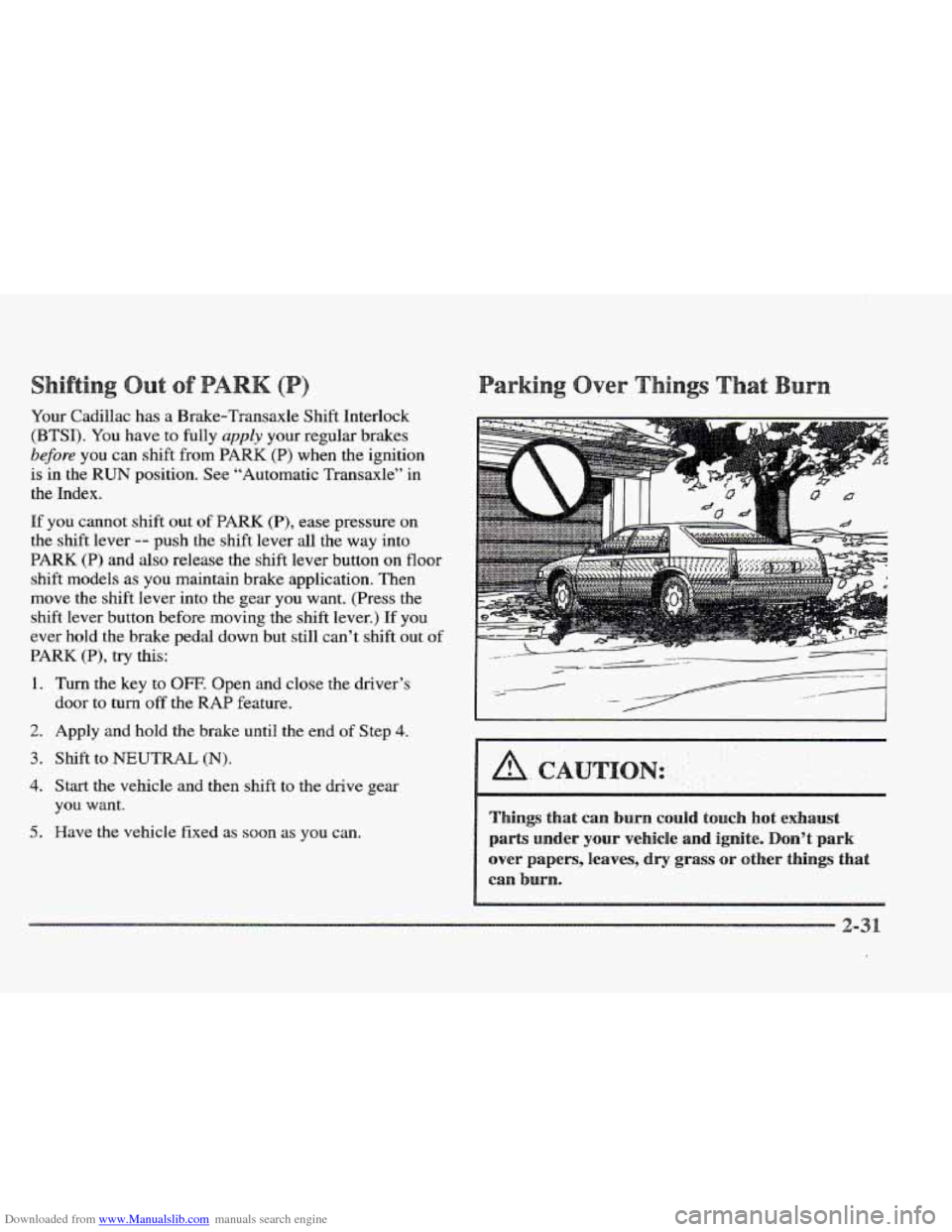
Downloaded from www.Manualslib.com manuals search engine Your Cadillac has a Brake-Transaxle Shift Interlock
(BTSI).
You have to fully apply your regular brakes
before you can shift from PARK (P) when the ignition
is in
the RUN position. See “Automatic Transaxle” in
the Index.
If you cannot shift out of PARK (P), ease pressure on
the shift lever -- push the shift lever all the way into
BARK (P) and also release the shift lever button on floor
shift models as YOU maintain brake application. Then
move the shift lever into
the gear you want. (Press the
shift lever button before moving the shift lever.) If
you
ever hold the brake pedal down but still can’t shift out of
PARK (P), try this:
1. Turn the key to OFF. Open and close the driver’s
2. Apply and hold the brake until the end of Step 4.
door to turn off the RAP feature.
3. Shift to N-ErnRAE (N).
4. Start the vehicle and then shift to the drive gear
you want.
5. Have the vehicle fixed as soon as you can.
II
ings that can burn could touch h
parts under your vehicle and ignite
over papers, leaves, dry grass or other things that
can burn.
Page 95 of 361
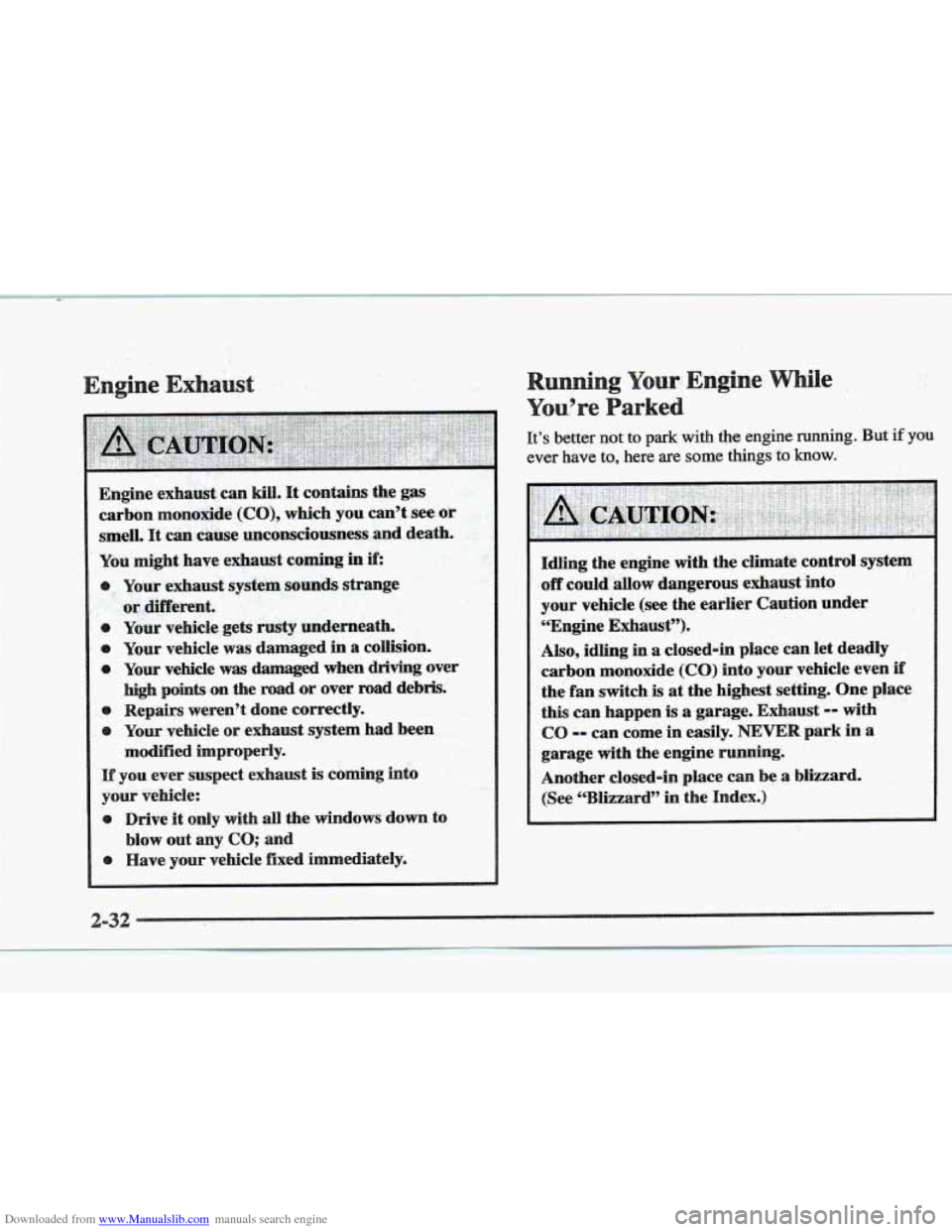
Downloaded from www.Manualslib.com manuals search engine Engine exhaust can kill. It contains the gas
carbon monoxide
(COj, which you can’t see or
smell. It Can cause unconsciousnessand death.
YOU might have exhaust coming in if:
e, your exhaust system. sounds strange
@ Your vehicle gets rusty’underneath.
6~ Your vehicle was damaged in a collision.
@ Your vehicle was damaged when driving over
high pints on the road or over road debris.
Repairs weren’t done correctly.
modified improperly.
or Werent. ..
(B Your vehicle or exhaust system had been
pf you ever suspect exhaust is coming into
your vehicle:
Drive it only with all the windows
down to
blow
out any CQ; and
8 Have your vehicle fixed immediately.
Engine e,
It’s better not to park with the engine running. But if you
ever have to, here are some things to know.
Idling the engine with the climate control system
off cdd. allow dangerous exhaust ‘into
’:“ 5. 11
your’vehicle (see the earlier Caution under
“Engine Exhaust’,’)
.
Also, idling in a closed-in place can let deadly
carbon monoxide
(CQ) into your vehicle even if
the,fan switch is at the highest setting. Qne place
this can happen is a garage. Exhaust -- with
CO -- can come in easily. NEVER park in a
garage
with the engine running.
Another closed-in place can
be a blizzard.
(See C6Blizzard” in the Index.)
Page 96 of 361
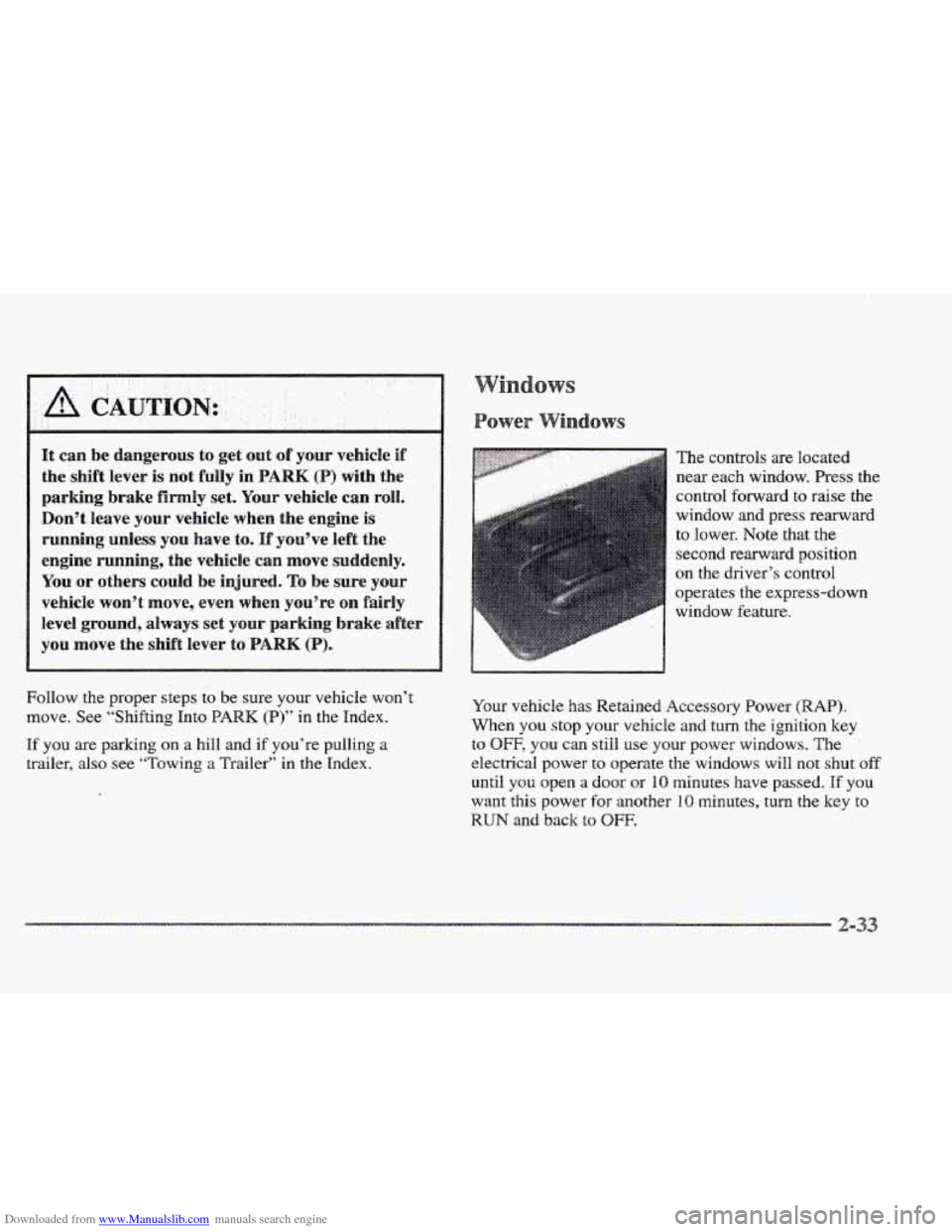
Downloaded from www.Manualslib.com manuals search engine It can be dangerous to get out of your vehicle if
the shift lever is not fully in PARK (P) with the
parking brake firmly
set. Your vehicle can roll.
Don’t leave your vehicle when the engine
is
running unless you have to. If ydve left the
engine running, the vehicle can move
suddenly.
You or others cou%d be injured. TQ be sure your
vehicle move, even when you’re on fairly
level ground, always set your parking brake after
Follow the proper steps to be sure your vehicle won’t
move. See “Shifting Into
PARK (P)” in the Index.
If you are parking on a hill and if you’re pulling a
trailer, also see “Towing a Trailer” in the Index.
:rat~~~~~j,~.~.~.~~~:..i .I... . , .. :-., The controls are located
near each window. Press
the
control forward to raise the
window
and press rearward
to lower. Note that the
second rearward position
on the driver’s control
operates
the express-down
window feature.
Your vehicle has Retained Accessory Power (RAP).
When you stop your vehicle and turn the ignition key
to
OFF, YOU can still use your power windows. The
electrical power
to operate the windows will not shut off
until you open a door or 10 minutes have passed. If you
want this power
for another 10 minutes, turn the key BQ
RUN and back to OFF.
Page 97 of 361
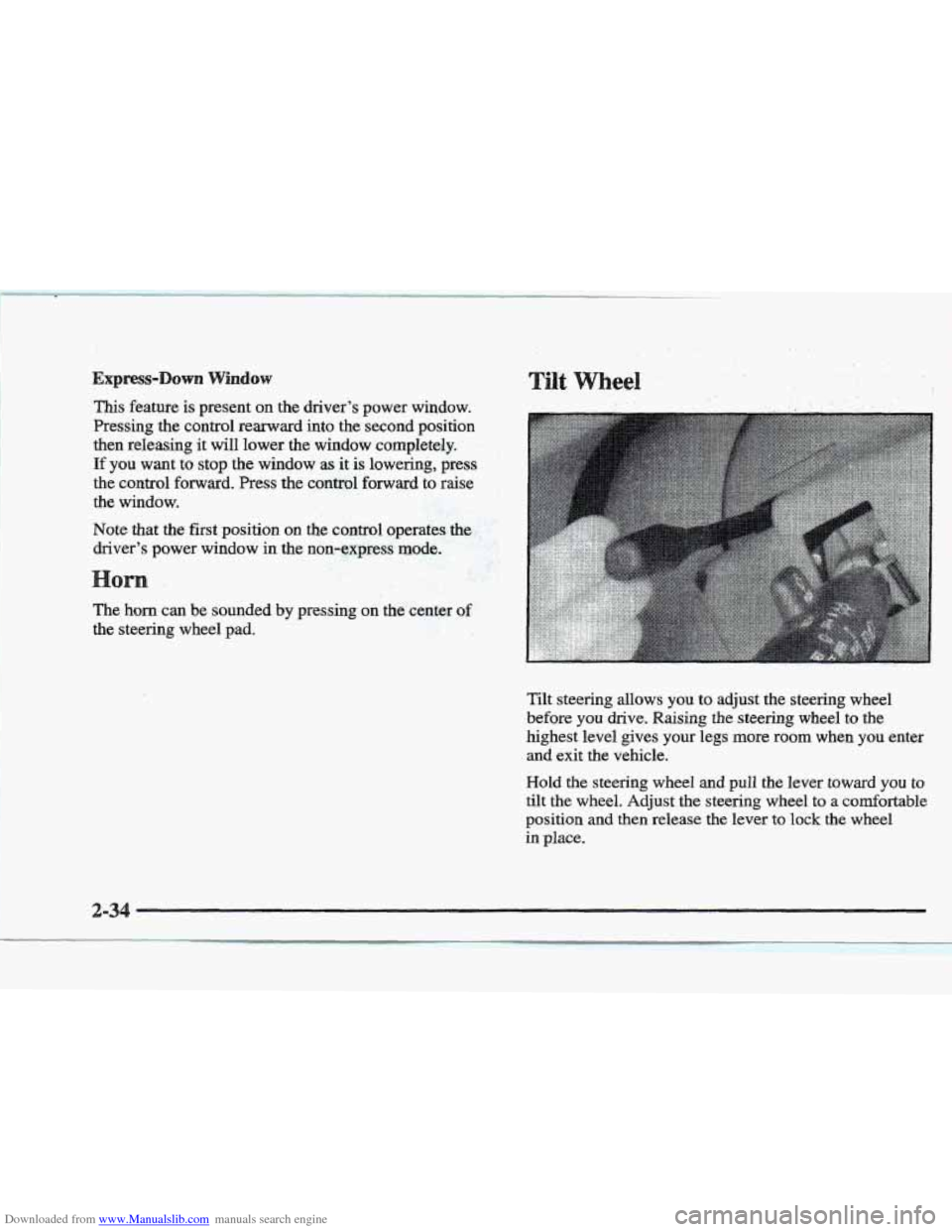
Downloaded from www.Manualslib.com manuals search engine EX~ESS-DOWR Whdow
This feature is present on the driver’s power window.
Pressing the control rearward into the second
position
then releasing it will lower the window completely.
If you want to stop the window as it is lowering, press
the control forward. Press the control, .. forward to raise
the window.
Note that
the first position on the control operates the
driver’s power window in the non-express mode.
The
horn can be sounded by pressing on the center of
the steering wheel pad.
Tilt steering allows you to adjust the steering wheel
before
you drive. Raising the steering wheel to the
highest level gives your legs more room when you enter
and exit the vehicle.
Hold the steering wheel and pull the lever toward you to
tilt the wheel. Adjust the steering wheel to a comfortable
position
and then release the lever to lock the wheel
in place.
2-34
I
Page 98 of 361
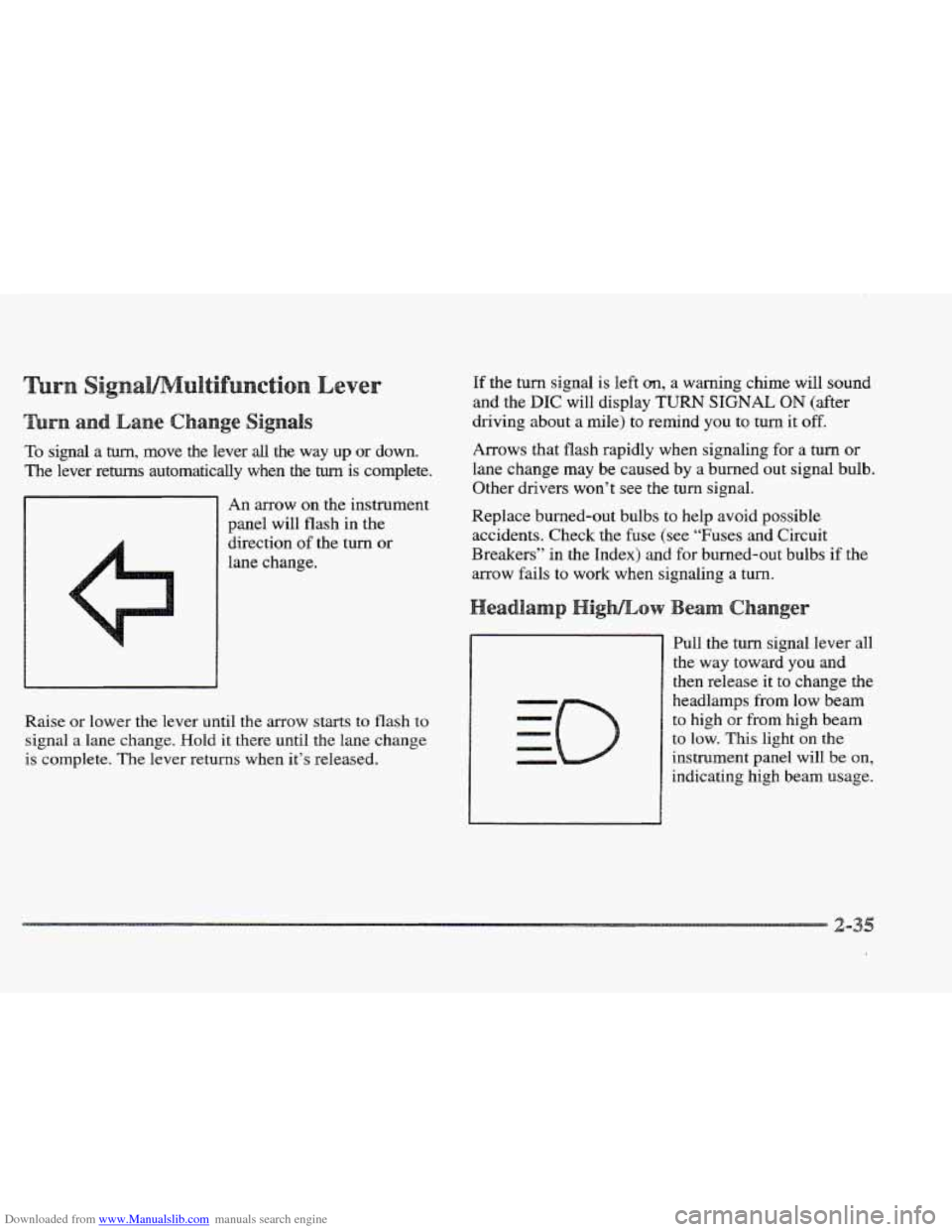
Downloaded from www.Manualslib.com manuals search engine To signal a turn, move the lever all the way up or down.
The lever returns automatically when the turn is complete.
An arrow on the instrument
panel will flash in the
direction of
the turn or
lane change.
Raise or lower the
lever until the arrow starts to flash to
signal a lane change. Hold
it there until the lane change
is complete. The lever returns when it’s released.
If the turn signal is left an, a warning chime will sound
and the
DIC will display TURN SIGNAL ON (after
driving about a mile) to remind you to turn it
off.
Arrows that flash rapidly when signaling for a turn or
lane change may be caused by a burned out signal bulb.
Other drivers won’t see the
turn signal.
Replace burned-out bulbs to help avoid possible
accidents. Check the fuse (see “Fuses and Circuit
Breakers”
in the Index) and for burned-out bulbs if the
arrow fails to work when signaling
a turn.
Pull the turn signal lever all
the way toward you and
then release it to change the
headlamps
from low beam
to high or from high beam
to low. This light on the
instrument panel will be on,
indicating high beam usage.
Page 99 of 361
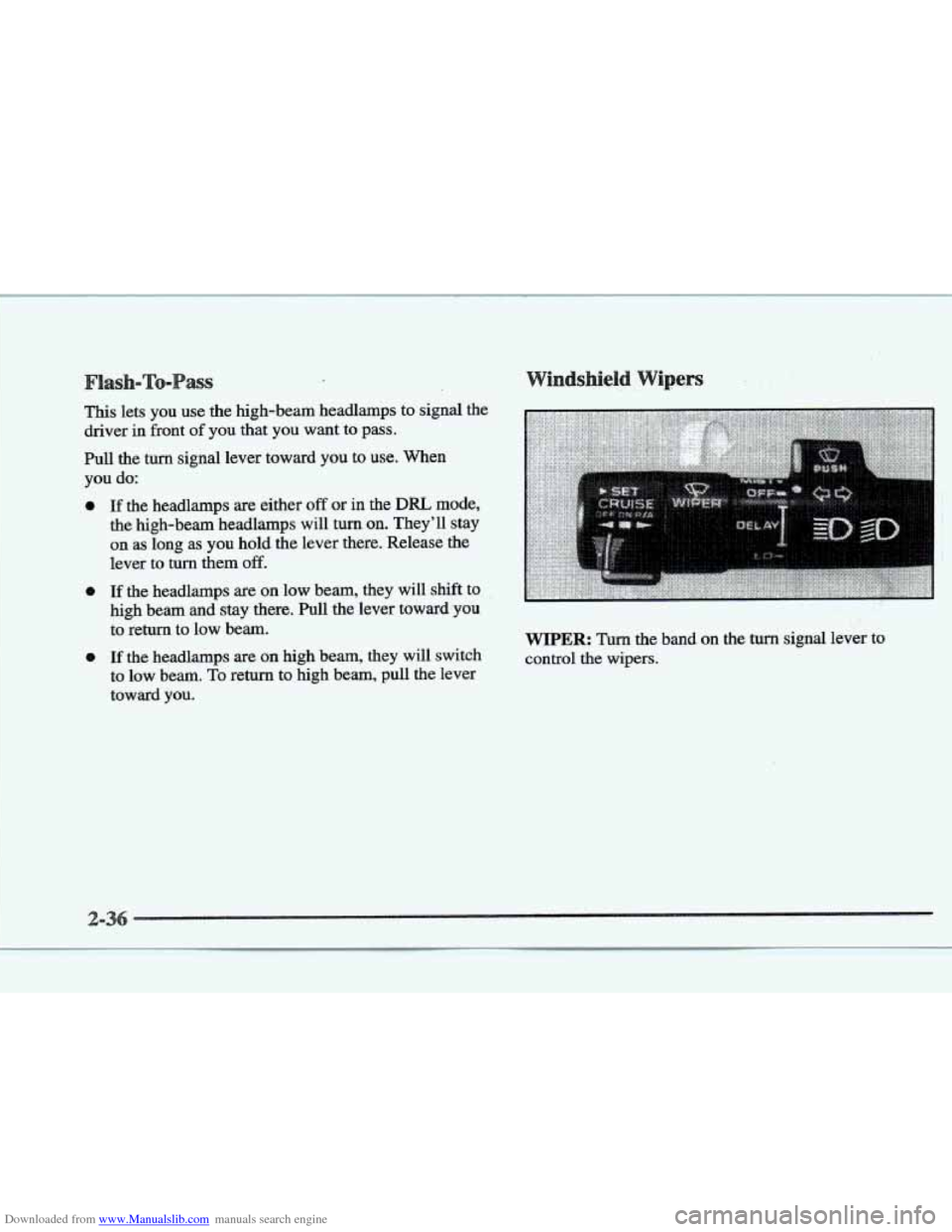
Downloaded from www.Manualslib.com manuals search engine s
This lets you use the high-beam headlamps to signal the
driver in front of you that you want to pass.
Pull the turn signal lever toward
you to use. When
you do:
a
e
e
If the headlamps are either off or in the DRL mode,
the high-beam headlamps will turn
on. They’ll stay
on as long as you hold the lever there. Release the
lever to turn them off.
If the headlamps are on low beam, they will shift to
high beam and stay there. Pull the lever toward you
to return to low beam.
If the headlamps are on high beam, they will switch
to low beam.
To return to high beam, pull the lever
toward you.
I
WIPER: Turn the band on the tum signal lever to
control the wipers.
Page 100 of 361
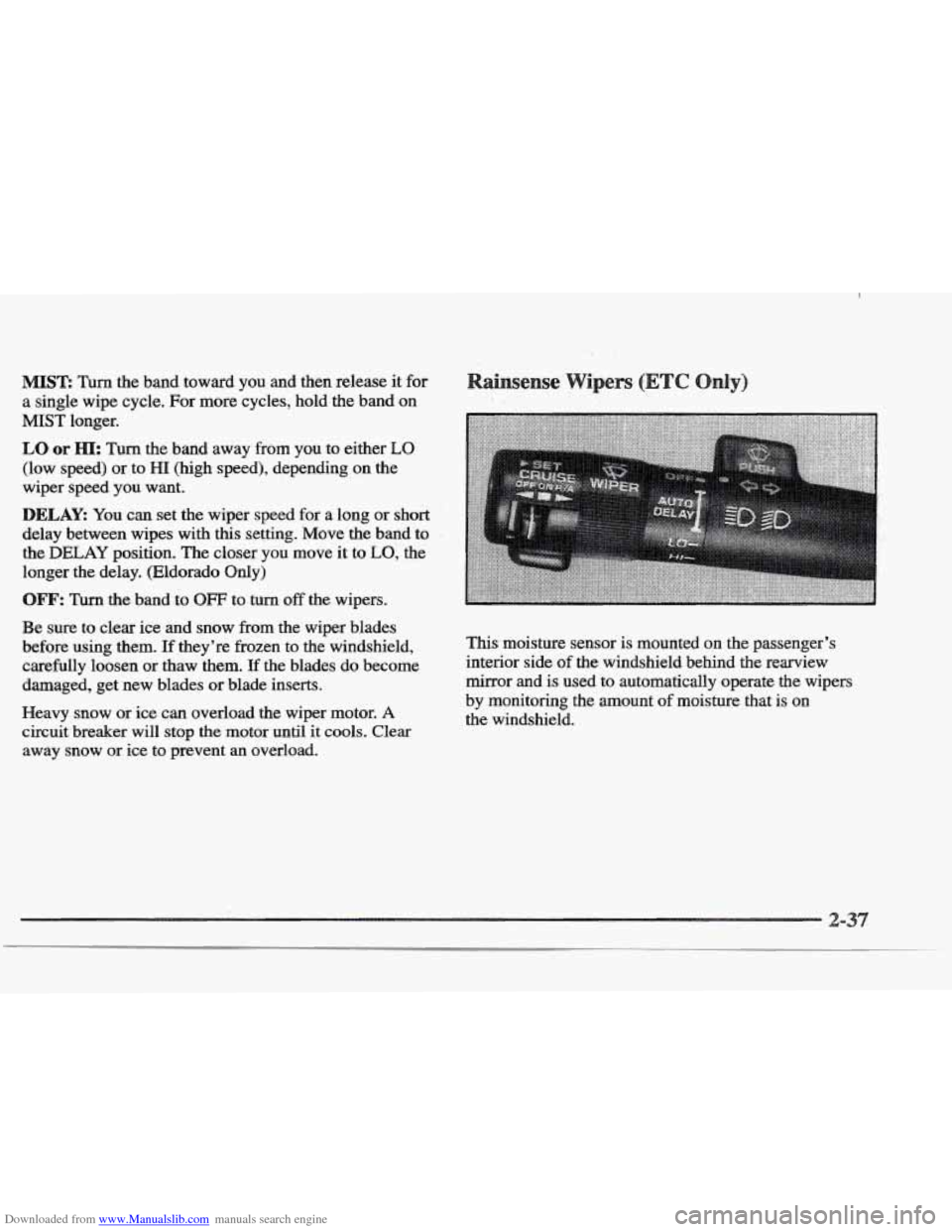
Downloaded from www.Manualslib.com manuals search engine MIST: Turn the band toward you and then release it for.
a single wipe cycle. For more cycles, hold the band on
MIST longer.
LO or HI: Turn the band away from you to either LO
(low speed) or to HI (high speed), depending on the
wiper speed
you want.
DELAY: You can set the wiper speed for a long or short
delay between wipes with this setting. Move the band to
the
DELAY position. The closer you move it to LO, the
longer
the delay. (Eldorado Only)
OFF’: Tun the band to OFF to turn off the wipers.
Be sure to clear ice and snow from the wiper blades
before
using them. If they’re frozen to the windshield,
carefully loosen or thaw them.
If the blades do become
damaged, get new blades or blade inserts.
Heavy snow or ice can overload the wiper motor.
A
circuit breaker will stop the motor until it cools. Clear
away snow or ice to prevent an overload. This-moisture
sensor
is mounted on the passenger’s
interior side
of the windshield behind the rearview
mirror and
is used to automatically operate the wipers
by monitoring
the amount of moisture that is on
the windshield.